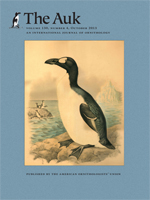Regular replacement of flight feathers is one of the most time-consuming activities in the annual cycle of flying birds. In principle, birds can decrease the time required to renew feathers by increasing the rate at which individual feathers grow and by growing more feathers simultaneously. Using 52 comparisons of 43 species from 26 families of birds that maintain the ability to fly while molting, we show that the average number of primary feathers growing simultaneously explains 60.0% of the variation in mass-corrected molt duration, whereas feather growth rate explains only 4.4% of the variation in mass-corrected molt duration. The trend is even stronger when species that grow all their primaries simultaneously are included in the analysis. We suggest that the rate at which feather tissue is produced cannot increase without compromising feather quality because the size of the feather follicle constrains the speed at which feathers can be generated. Thus, birds that must molt rapidly to meet time constraints in their life cycle may be forced to reduce the time spent molting mostly by growing more feathers simultaneously.
How to translate text using browser tools
1 October 2013
How do Birds Adjust the Time Required to Replace their Flight Feathers?
Vanya G. Rohwer,
Sievert Rohwer
ACCESS THE FULL ARTICLE

The Auk
Vol. 130 • No. 4
October 2013
Vol. 130 • No. 4
October 2013
feather growth rate
feather quality
molt intensity
ptilochronology




